Best Google Tasks Alternatives in 2025: Top 15

Are you finding that Google Tasks doesn’t quite cut it when it comes to managing to-do lists, setting reminders, and organizing key project management tasks across multiple devices?
While it’s free and available for use across various Google platforms, Google Tasks doesn’t always offer the flexibility, control, and other features that some businesses require.
It’s common for businesses to search for a Google Tasks alternative. The good news, if you’re looking for tools to boost team performance, is that we’ve already done the legwork for you by sourcing 15 of the best Google Tasks alternatives on the market.
Let’s get straight into it…
What is Google Tasks and Why are People Looking for Alternatives to Google Tasks?
Google Tasks is a basic task management application and productivity tool that allows users to create, manage, and track to-do lists and tasks as part of project management.
The app is useful for businesses that need:
- Integration with Gmail and Google Calendar: Tasks can be added directly from emails and viewed alongside calendar events.
- Subtasks and details: Tasks can include subtasks, due dates, and additional notes.
- Mobile and web access: Users can access the Google Tasks mobile app (iOS and Android) or from the sidebar in Gmail or Google Calendar on the web.
- Google Workspace integration: The app seamlessly works with other Google services and is a convenient add-on for existing Google environments.
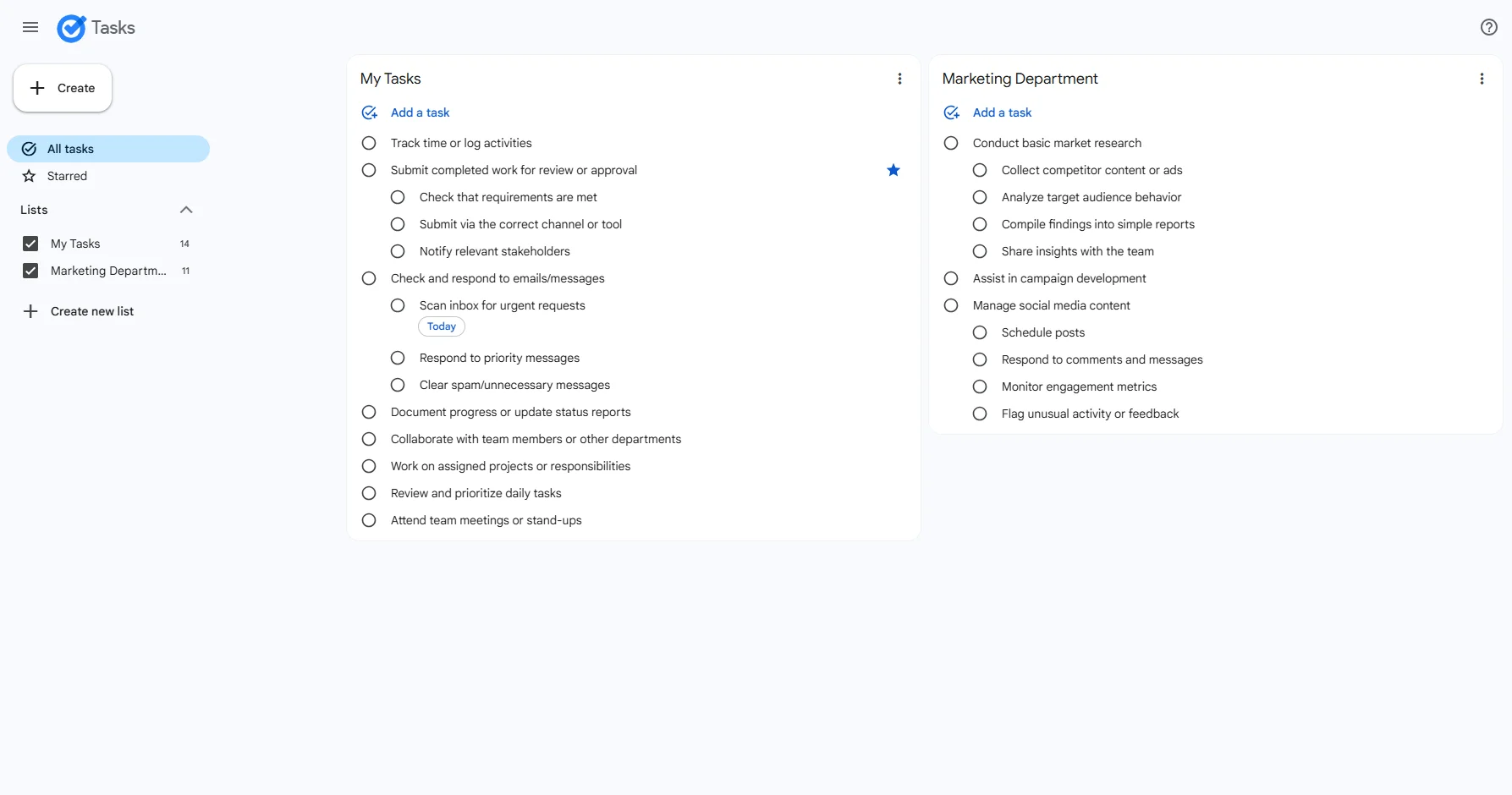
Discover the best Google Tasks alternatives in 2025 — modern tools that offer advanced task management, collaboration, and workflow automation
As a lightweight productivity tool, Google Tasks can assist professionals in quickly capturing tasks from anywhere, from any device, and tracking due dates and notifications.
So, why are Businesses Looking for Google Tasks Alternatives?
Small and medium businesses, startups, and enterprises often require more advanced task management tools as part of a comprehensive project management solution.
Google Tasks works best as a personal, professional or small-team productivity tool. It is not a project management platform and has some notable limitations, including:
- No team collaboration features (no assigning tasks to others or comments).
- No work visualization tools, like project timelines, Gantt charts or Kanban boards.
- No subtasks, task dependencies or complex hierarchies.
- No detailed project tracking or reporting/analytics.
- No file sharing, labeling of tasks or activity tracking.
- Limited organization (no labels, priorities or project-level views).
- Only basic reminders for task deadlines.
- No integration with third-party services.
- Very few customization options, e.g., no color themes.
These are the main reasons why businesses may seek an alternative to Google Tasks. We cover the best 15 tools below but first, a word about how we chose these tools…
How We Choose the Best Google Tasks Alternatives?
The best alternatives can do what Google Tasks does — but other things as well, making up for some of the weaknesses outlined above.
Most of the Google Tasks alternatives we’ve chosen are free — or at least offer a free plan as part of their overall package. Most also offer mobile and web apps as standard.
As we compiled our list of 15 tools, we considered:
- Pricing: the monthly costs and what the free plan offers, which is always a consideration for any business.
- Integration capabilities: how easily the software integrates with third-party software, especially Google Workspace, which impacts the installation process and how smoothly everything operates afterward.
- Special features: an assessment of the main features of each tool so that business owners and IT departments — especially those already using Google Workspace — can decide whether they are right.
- Сustomization capability: how much the task management software can be personalized for individual business needs.
Overview of Top 15 Best Google Tasks Alternatives in 2025
Not all of the tools we cover below will be right for you. The following table offers an at-a-glance view of the best alternatives to Google Tasks. More detail on each tool is provided in the sections after the table if you need more of the nitty-gritty info before choosing the most suitable tool.
| Name | Kanban | Integration Capabilities | Customization Capabilities | Key Benefits |
|---|---|---|---|---|
| Kanbanchi | ✅ | Deep integration with Google Workspace. | Flexible customization for individual needs.
Cards, lists and boards can be customized. Tasks can be color-coded for easy sorting and prioritization. |
|
| Trello | ✅ | Limited integration with Google Workspace (Power-ups needed). | Customization for businesses, teams & individuals.
Cards & boards can be color-coded and reflect company branding. |
|
| ClickUp | ✅ | Good integration with Google Workspace but not native. | Forms, fields, reports, task types, etc., are customizable for businesses, teams & individuals. |
|
| Wrike | ✅ | Good integration with Google Workspace but not Google-focused. | Forms, fields, reports & task types are customizable. |
|
| Zoho Projects | ✅ | Main focus of its integrations is with the Zoho ecosystem. | Task transitions can be automated & customized with rules & approvals within Blueprints.
Fields, reports & more are also customizable. |
|
| Smartsheet | ✅ | Good integration with Google Workspace but not native. | Fully customizable spreadsheets for businesses, teams & individuals.
Reports, dashboards, and templates are also customizable. |
|
| Notion | ✅ | Non-native integration with Google Workspace. | Fully customizable task databases, boards, lists, calendars, and tables.
Custom workflows. |
|
| Monday.com | ✅ | Integration with Google Workspace using add-ons but requires configuration. | Customizable workflows, task fields & dashboards. |
|
| Jira | ✅ | Integrations are geared towards the Atlassian marketplace. | Customizable fields, dashboards, workflows, issue types, views, screens & layouts. |
|
| ToDoist | ✅
Basic |
Integrations with Google Workspace, Calendar, etc. but not native. | Customizable task & project structure, filters, templates, and views. |
|
| Any.do | ✅
Paid plans only |
Integrates with Gmail, Google Calendar, etc. | Customizable views, templates, lists/folders, tags, recurring tasks, reminders & themes. |
|
| Remember the Milk | No | Integrates with Gmail and Google Calendar, etc. | Customizable lists, tags, priorities, views, and reminders (mainly in the Pro version). |
|
| TasksBoard | ✅
Basic |
Full native integration with Google Workspace. | Customizable labels & tags, themes, list management, etc. |
|
| TickTick | ✅ | Lacks deep integration with Gmail, Google Calendar, etc. | Custom themes, sort orders & personalized views for different task types/contexts. |
|
| OmniView | No | No deep integration with Google Workspace (designed for Mac environments). | Many customizations available for Mac environments. |
|
Kanbanchi
Kanbanchi is a visual task management tool that is deeply integrated with Google Workspace — and, therefore, a prime candidate as one of the best Google Tasks alternatives.
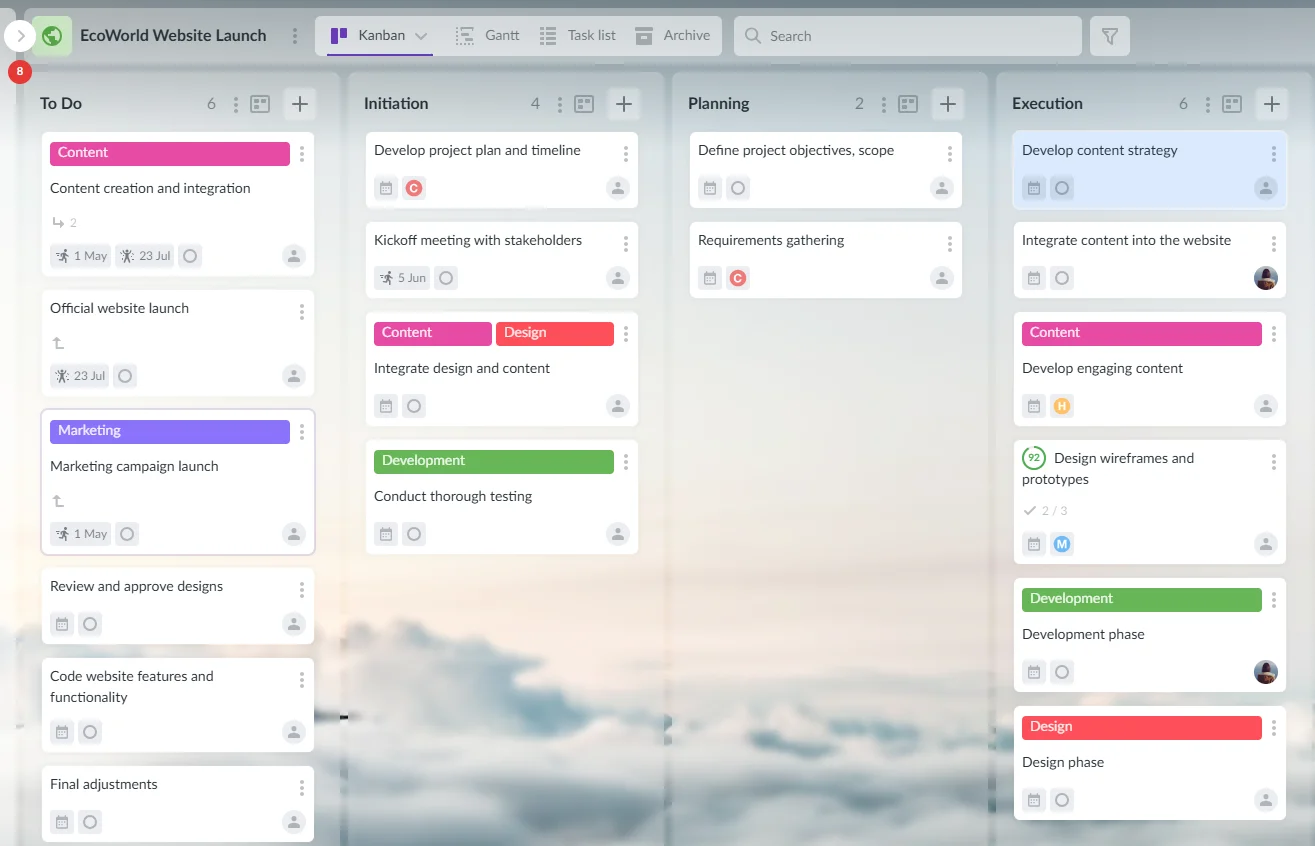
Kanbanchi’s flexible Kanban board transforms brainstorming into actionable plans — perfect for mapping out your Business Model Canvas visually
Built from the ground up for the Google work environment, small and medium-sized teams can not only manage tasks but do so by creating Kanban boards, Gantt charts, and task lists, collaborating in real-time, and tracking time all in one simple-to-use platform.
Kanbanchi allows agile teams, freelancers, and remote workers to coordinate and manage projects efficiently while switching seamlessly between Gmail, Google Drive, and Google Calendar.
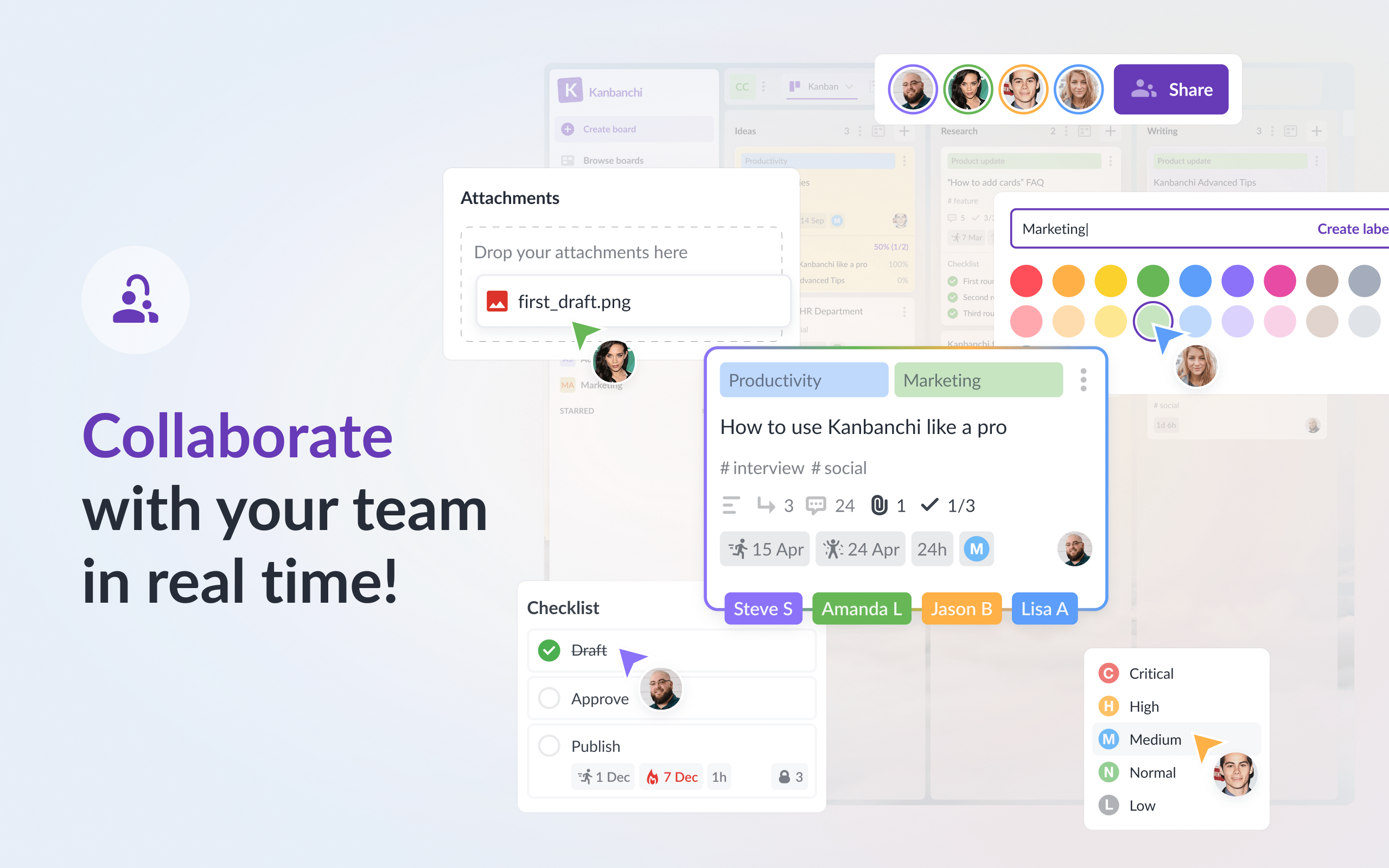
Keep your team on the same page with real-time task updates — collaborate seamlessly, track progress, and hit deadlines together
Unlike standalone task managers, such as Trello, Kanbanchi operates inside Google Workspace, making it simple to turn emails into tasks, sync deadlines with Google Calendar, and attach Drive files directly to cards.
This native Google focus makes it ideal for businesses looking for more control over their project processes within the Google Workspace environment.
Standout Features:
- Native Google Workspace integration: Seamlessly embeds within Google’s ecosystem (Gmail, Drive, Calendar, Docs) without switching tabs/apps.
- Multiple work views: Kanban board, Gantt charts, and task list views according to the preferences/needs of teams.
- Time-tracking and productivity reports: built-in time logging and analytics help businesses monitor efficiency.
- Real-time collaboration: live team collaboration with zero latency, similar to working in Google Docs.
- Customizable workflows: boards are adaptable for any process, such as software development, marketing, sales, HR, etc.
Pros:
- Deep Google integration (Gmail to tasks in one click).
- Multiple views in one tool.
- Affordable pricing.
- Utilizes Google
- Cloud infrastructure with security compliance.
- Minimal learning curve.
Cons:
- Mobile app is basic (the web version is stronger).
- No built-in chat (relies on Google Meet/email).
Team Size Scalability
Best for: all team sizes.
Pricing
Free plan: Limited to 36 cards
Paid plans:
- Essential: $3.97/user/month*
- Premium: from $6.47/user/month
- Professional: from $24.47/user/month
- Enterprise: from $12.95/user/month
*All prices quoted in this article are based on annual pricing.
BOOK A FREE TRIAL OF KANBANCHI
Trello
Trello, part of the Atlassian suite of software solutions, is another visual task management tool often used by freelancers, and small and midsized teams when managing projects.
Within the Google ecosystem, Trello works but it is not natively integrated (like Kanbanchi is). Power-ups are needed for integration. This increases the learning curve for users and means that some of the tasks get a little “clunky”, such as attaching Google Drive docs to Trello cards.

Trello’s intuitive Kanban boards turn your Business Model Canvas into a visual, drag-and-drop workflow — simple yet powerful for any team
With Trello, it’s easy to visualize tasks and workflows and the free plan offers most of the features that individuals or small teams look for in free task management tools, though not necessarily within a Google environment.
Standout Features:
- Power-ups for integrations with Google Drive, Gmail, Google Calendar, Google Meet, etc.
- Kanban board and list views for work organization.
- User-friendly interface on web, mobile, and desktop.
Pros:
- Integrates with Google Workspace through add-ons (power-ups).
- Collaboration-friendly with task assignments, comments, due dates, attachments, etc.
- Easy to organize and view workflows.
- Performs well across web, mobile, and desktop platforms.
Cons:
- Learning curve with power-ups.
- Potential security/privacy issues for unpaid versions.
Team Size Scalability
Best for: Small to midsize teams (5-50 users).
Pricing
Free plan: Basic features for up to 10 collaborators per workspace.
Paid plans:
- Standard: $5/user/month
- Premium: $10/user/month
- Enterprise: $17.50/user/month
ClickUp
ClickUp is a comprehensive, all-in-one platform for productivity and collaboration on projects. Although one of the best free Google Tasks alternatives, this tool is far more advanced and does a lot more than simple task management.
For instance, it offers multiple work view options, such as Kanban boards, Gantt Charts, calendar views, mind maps, and lists. Its task management features allow you to track changes, create schedules, and create reports.
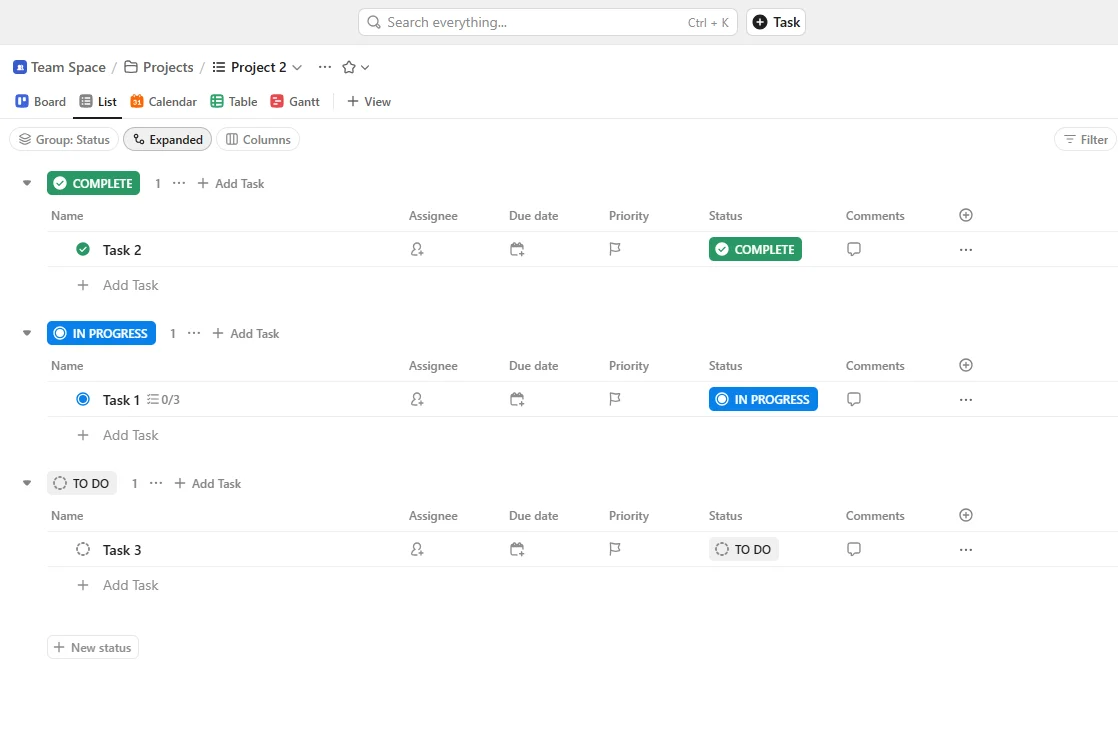
ClickUp combines task lists, statuses, and automation to help teams structure even the most complex workflows with ease
While that may sound like a plus, a centralized work hub like this may be overkill for some professionals or small businesses simply requiring basic task management tools. ClickUp’s advanced features and steep learning curve may be more suited to midsize to larger businesses and enterprises.
Standout Features:
- Multiple work views including mind maps, Kanban boards, Gantt Charts, lists, etc.
- Supports tasks, subtasks, checklists, dependencies, time tracking, goals, etc.
- Can track changes, create schedules, and create reports.
Pros:
- Easy to assign tasks to teams.
- Flexible with multiple work views.
- Scalable for larger teams.
- Collaboration-friendly with checklists, whiteboards, attachments, comments, etc.
- Highly customizable with advanced features.
Cons:
- Steep learning curve with so many features.
- Occasional Google Workspace integration issues as it’s not native.
- Confusing or cluttered user interface for some users.
Team Size Scalability
Best for: Midsize to large teams (50-500 users)
Pricing
Free plan: Basic features with 100 MB of storage space.
Paid plans:
- Unlimited: $7/user/month
- Business: $12/user/month
- Enterprise: Custom pricing
Wrike
Wrike is another high-level alternative to Google Tasks, It is impressive in its scalability and well-suited to midsize or larger organizations with complex project management demands — but may be overkill for smaller organizations or individuals looking for simple task management tools.
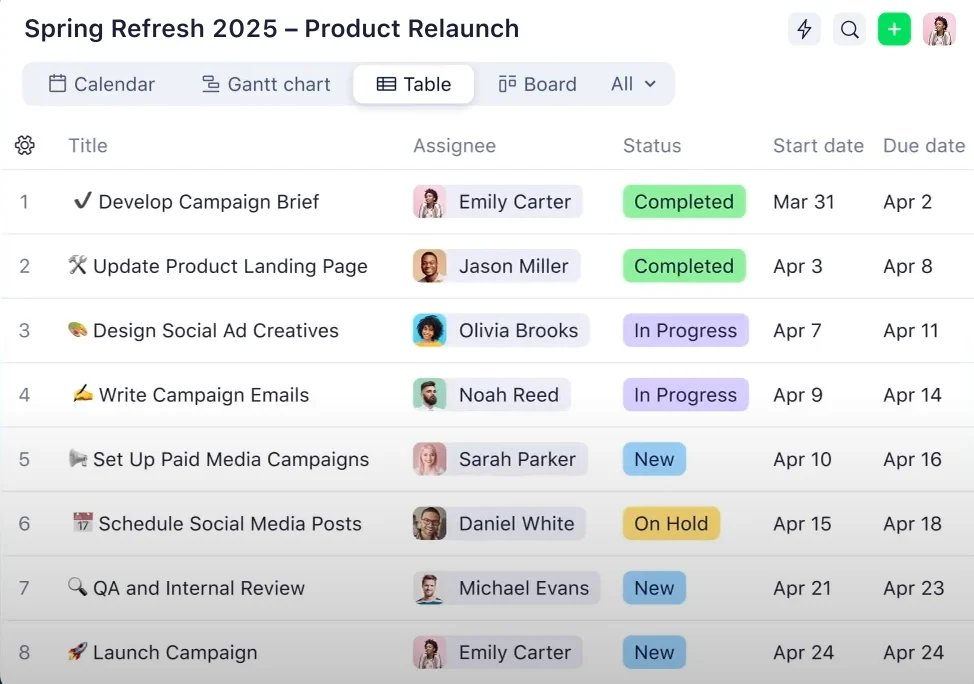
Wrike’s detailed task lists make managing big initiatives like product relaunches clear and trackable — keeping every milestone in view
Wrike bills itself as an all-in-one platform for managing projects, organizing workflows, and enhancing team collaboration. Ideal for medium to large teams that require secure, scalable project management with advanced reporting and collaboration tools, Wrike also offers custom solutions for enterprises.
Standout Features:
- Custom dashboards, workload charts, time tracking, and real-time reports.
- Enterprise-grade security and permissions.
- Extensive collaboration tools, including real-time editing, sharing, and team communication tools.
Pros:
- Integrates with third-party apps such as Google Drive, Microsoft Teams, Dropbox, etc.
- Comprehensive and customizable project management tools and interfaces.
- Advanced reporting features for performance tracking.
- Robust security and privacy.
- Well-developed mobile app available (Android and iOS).
Cons:
- More expensive starting point for paid versions.
- Not Google-focused with its integrations.
- Overkill for smaller teams, with a steep learning curve when onboarding.
- Occasional speed issues reported.
Team Size Scalability
Best for: Midsize to large teams (50-500 users).
Pricing
Free plan: Basic features but limited to 200 active tasks, including subtasks.
Paid plans:
- Team: $10/user/month
- Business: $25/user/month
- Enterprise/Pinnacle Plans: Custom pricing
Zoho Projects
Zoho is a well-established name in CRM software and Zoho Projects is part of a growing suite of 45+ tools that help businesses manage work, customers, employees, and business processes.
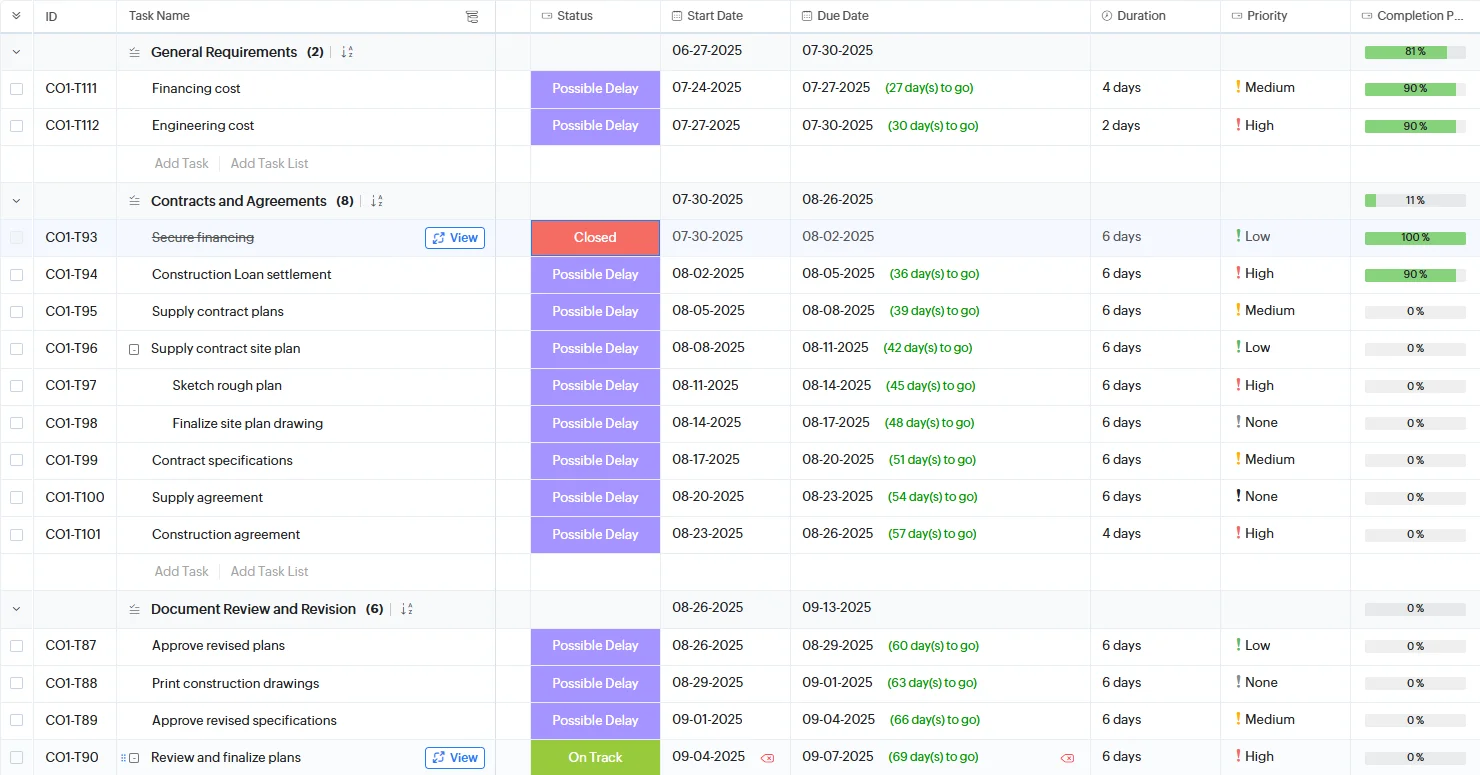
Zoho Projects’ task lists give your team a clear overview of responsibilities, deadlines, and project milestones — all in one place
While Zoho Projects is not focused on task management, it may be a viable alternative to Google Tasks for small to mid-sized businesses and enterprises that already use the Zoho ecosystem for CRM, recruitment or sales.
The software allows you to plan and manage tasks, teams, and timelines with several workflow views and extensive collaboration from one central platform.
Standout Features:
- Project template library.
- Blueprints to map out complicated tasks.
- Extensive synching with other Zoho tools and Google Workspace.
Pros:
- Good for complex tasks.
- Scalability with an extensive feature set and many potential integrations.
- Lower starting pricing than most other project management tools.
- Many customization options.
- Ticket-based support system with extensive user community.
Cons:
- User-unfriendly interface for some users.
- Not Google-focused.
Team Size Scalability
Best for: Midsize to large teams (50-500 users)
Pricing
Free plan: Basic features for up to 3 projects and 5GB of storage
Paid plans:
- Premium: $4/user/month
- Enterprise: $9/user/month
Smartsheet
Smartsheet is another of the Google Tasks alternatives suitable for larger organizations, government agencies, and enterprises. These organizations often require wider project management software in addition to all the features of standard task management tools.
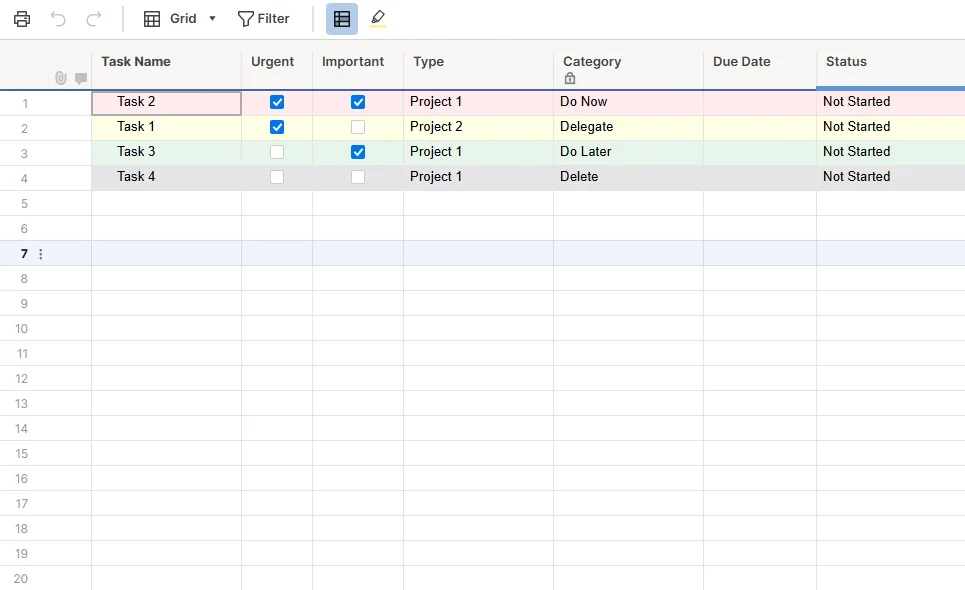
Smartsheet’s simple checkbox system turns everyday task tracking into a powerful, spreadsheet-style project management tool
With a familiar spreadsheet-based system, multiple work views, a large template library, and extensive integrations, Smartsheet is secure, scalable, and customizable for businesses that need to manage, automate, and report on tasks within work projects.
Smartsheet integrates with Google but has a relatively low rating from Google Workspace Marketplace users.
Standout Features:
- Spreadsheet-based interface with simple drag-and-drop functionality.
- Powerful teamwork collaboration tools.
- Extensive automation tools for workflows and document generation.
Pros:
- Extensive integrations available.
- Simple transition for professionals using Excel/Google Sheets.
- Good for collaboration and automated workflows.
- Scalable for large organizations.
- Enterprise-ready with advanced security.
Cons:
- No free version (though free trials available).
- Low Google Workspace rating from users.
- Steep learning curve with more advanced features.
Team Size Scalability
Best for: Midsize to large teams (from 50-500 users)
Pricing
Free plan: Basic features for up to 10 collaborators per workspace.
Paid plans:
- Pro: $9/user/month (1-10 members)
- Business: $19/user/month (3+ members)
- Enterprise: Custom pricing (10+ members)
Notion
Notion is an all-in-one workspace that can act as a simple Google Tasks alternative — or a tool that does much more besides, including note-taking, project management, database creation, and collaboration.
Notion was not designed for task or project management, but teams now use it widely to manage projects in a highly customizable and automated environment.
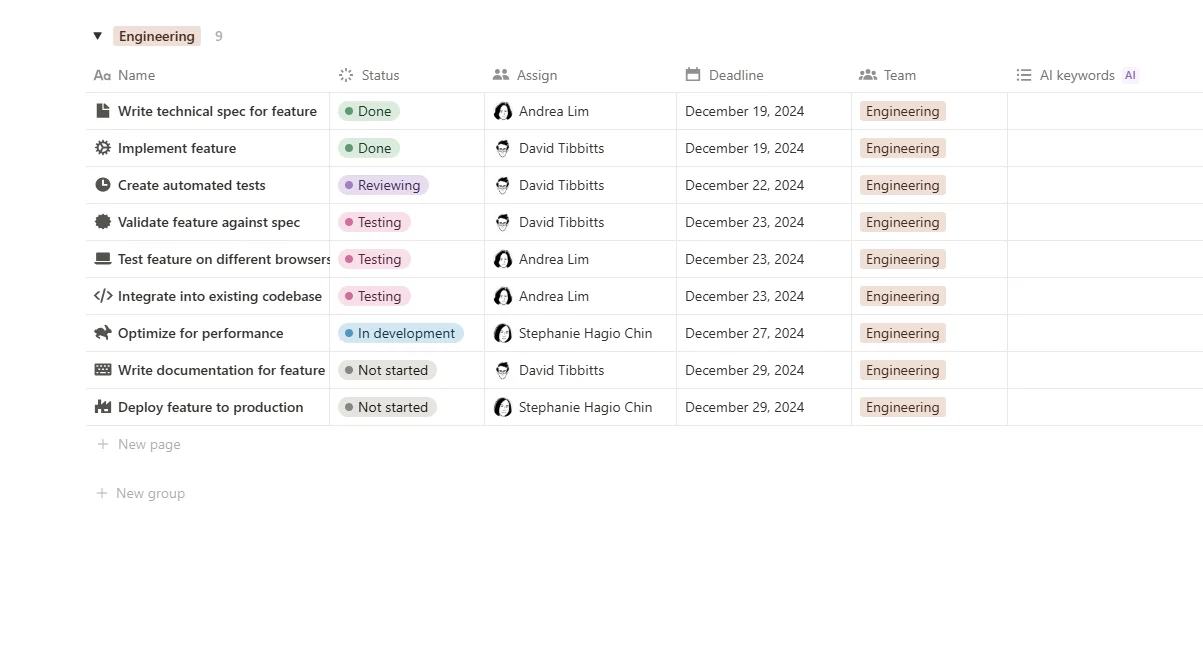
Notion’s flexible notes and task databases help you organize work processes, brainstorm ideas, and manage projects in one connected workspace
Notion lets you build task databases, boards, lists, calendars, and tables, and add properties like priority, status, tags, deadlines, or assignees to tasks. This goes far beyond Google Tasks’ capabilities. Multiple work view options, collaboration tools, and templates may be overkill for users looking for a tool for quick tasks and reminders.
Standout Features:
- Build task databases, boards, lists, calendars, and tables from a modular interface.
- Extensive project management and built-in collaboration features.
- AI automation and prebuilt templates.
Pros:
- All-in-one workspace for tasks, notes, project documentation, databases, and wikis.
- Good for deep task management and collaboration.
- Flexibility from many customization options.
- Many automation options to speed up tasks.
- Vibrant ecosystem of free and paid templates.
Cons:
- Free version limited to individual usage.
- No native Google integrations.
- May be slower (more clicks) than Google Tsks for quick tasks.
Team Size Scalability
Best for: Individuals and small to midsize teams (5-50 users).
Pricing
Free plan: Basic features for individuals.
Paid plans:
- Plus: $10/user/month
- Business: $20/user/month
- Enterprise: Custom pricing
Monday.com
Monday.com is an easy-to-use and free Google Tasks alternative that can also be used as project management software. It’s particularly geared towards individuals and small and medium businesses with non-complex projects.
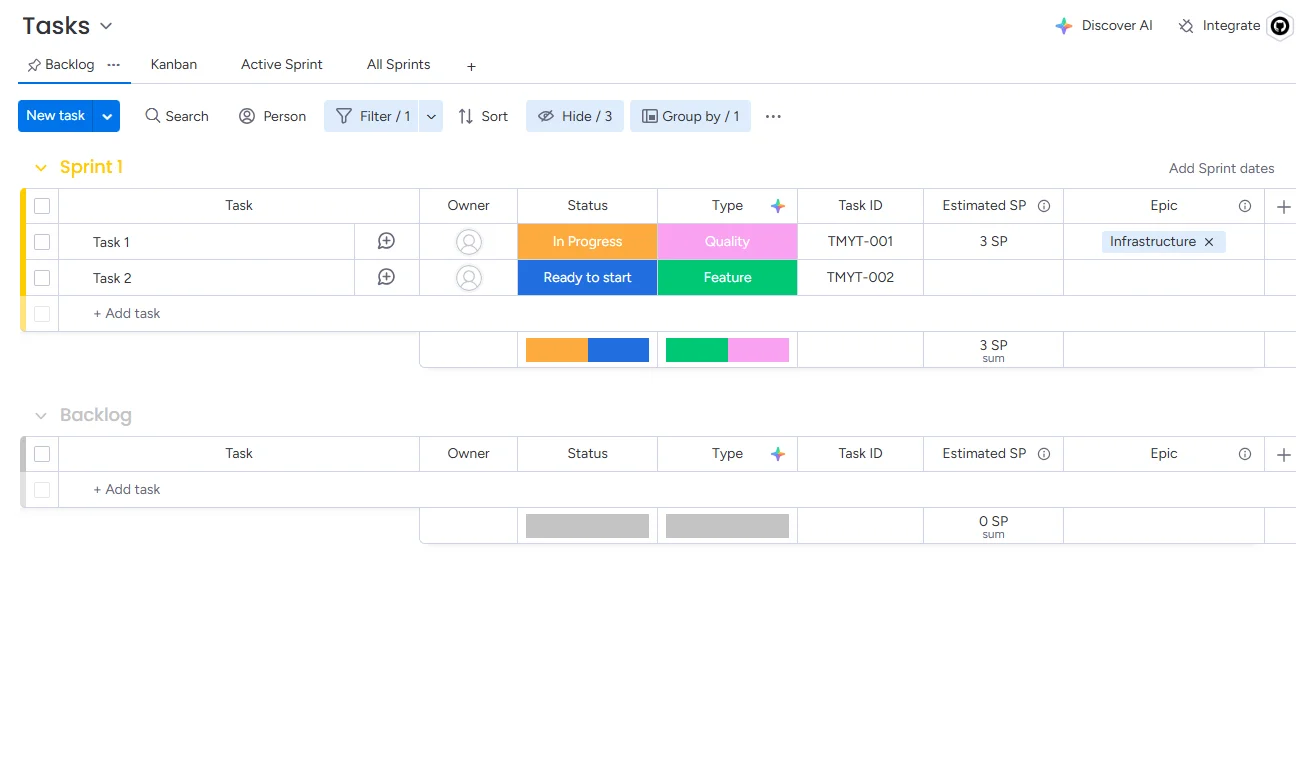
Monday’s flexible notes and task databases help you organize work processes, brainstorm ideas, and manage projects in one connected workspace
For setting deadlines, assigning tasks and resources, and tracking tasks, Monday.com works well. If you want it to do more than that, you’ll need to be a little more tech-savvy to customize the software for your needs — but it can operate as a fully functional project management tool.
Standout Features:
- Clean, colorful user interface.
- A library of in-built templates and tools for task and project management.
- Real-time view of task statuses, time tracking, and performance analytics.
Pros:
- Engaging design and easy-to-use interface.
- Allows simple and effective team collaboration.
- Streamlines work processes.
- Customizable workflows, dashboards, and task fields.
Cons:
- No native Google Workspace integrations.
- No native proofing features.
- Individuals may find it overkill for simple task management.
Team Size Scalability
Best for: Small to mid-sized teams and large enterprises (from 5-500 users)
Pricing
Free plan: Basic features for up to 2 users and 3 boards.
Paid plans:
- Basic: $9/user/month
- Standard: $12/user/month
- Pro: $19/user/month
Jira
Jira is another task management tool from the Atlassian “stable”. It was originally built to track issues in software development but has morphed into more of a full task-tracking and management tool for a range of issues and work items.
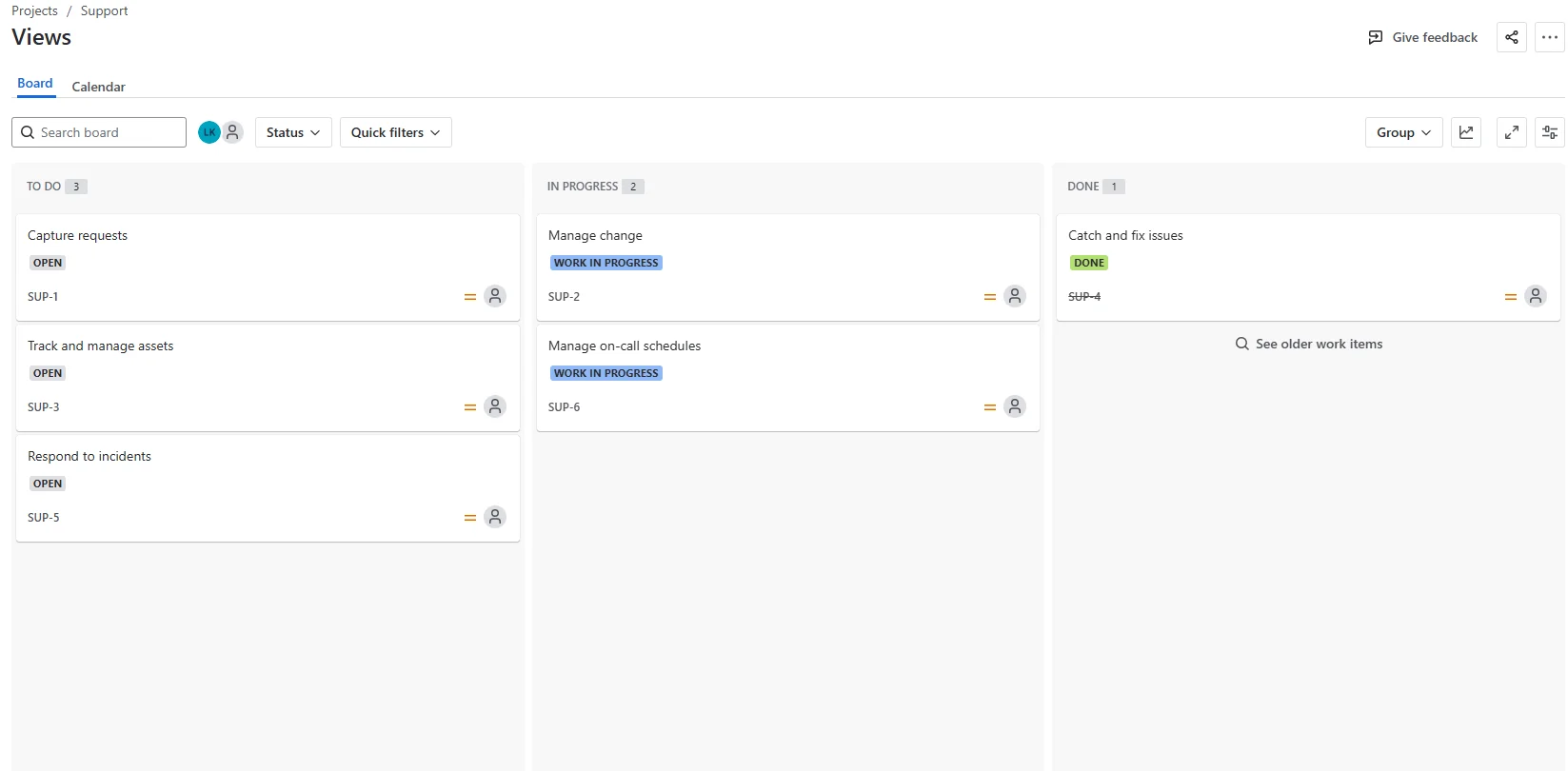
Jira’s robust Kanban boards bring structure to your Business Model Canvas — ideal for agile teams who need transparency and control
Like many of the Google Tasks alternatives outlined here, Jira offers multiple work views and good customization options. However, there’s no escaping its use mainly in the tech, software design, and ops fields, where issue tracking is a priority and issues can be complex.
For simple task management needs in other types of businesses, therefore, Jira may be overkill.
Standout Features:
- Detailed task history, priorities, and reporting available.
- No-code automation builder.
- Extensive integrations and marketplace.
Pros:
- Easy to plan and organize tasks.
- Designed to track project issues at scale.
- Customizable fields, workflows, issue types, views, screens, and layouts.
- Easy to prioritize and check progress on issues.
- Good for small teams with complex workflows.
Cons:
- Integrations are geared towards the Atlassian marketplace.
- Mobile app is not as good as the desktop or web app.
- Mainly used in IT, software design, and tech.
Team Size Scalability
Best for: Small to mid-sized teams and large enterprises in the tech space (from 5-1,000 users)
Pricing
Free plan: Basic features for up to 10 users with 100 automations/month.
Paid plans:
- Standard: $8.60/user/month
- Premium: $17/user/month
- Enterprise: Custom pricing
ToDoist
ToDoist is a true alternative to Google Tasks in that it is designed predominantly as a task management app. It does not offer many of the features of the other project management software tools included in this list but, as the name suggests, it does help businesses manage to-do task lists.
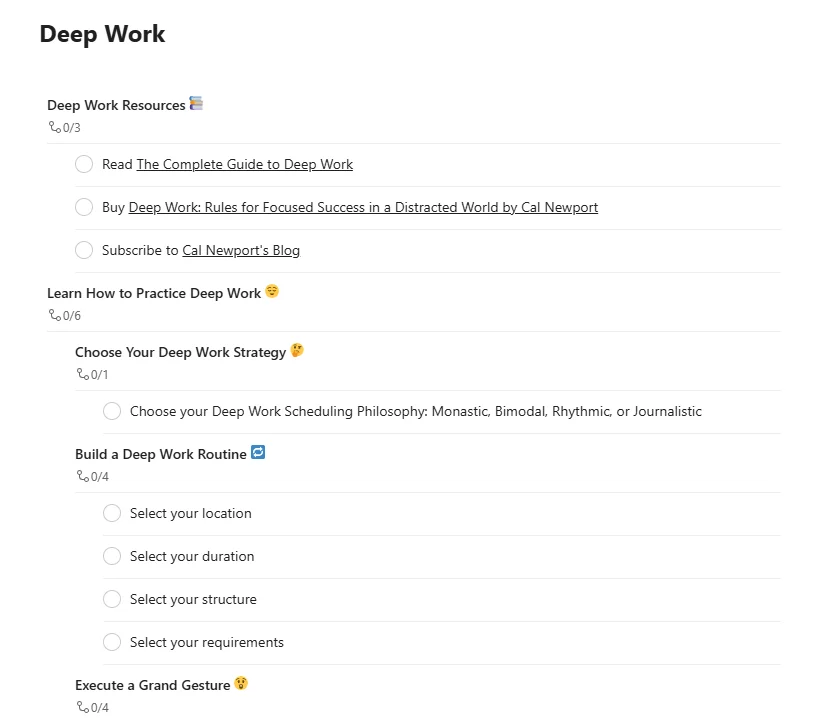
ToDoist makes structuring your business model simple with intuitive task lists and easy status tracking for daily productivity
Because of its focus solely on task management, ToDoist is a useful tool for professionals and teams looking to prioritize tasks and become more productive without a learning curve. However, if you need more advanced team collaboration and project functionality, you’ll be better off with a more advanced tool.
Standout Features:
- “Favorites” function helps users focus on key tasks.
- Priority levels, due dates and times, sub-tasks, and task reminders.
- Basic task views including lists, boards, and calendars.
Pros:
- Simplicity — easy to add tasks and recurring due dates.
- Totally focused on task management (like Google Tasks).
- Basic task collaboration available.
- Several task views available.
Cons:
- May be too basic for some users.
- Only tasks can have due dates — not projects.
- No native Google Workspace integration.
- AI assistant only in paid plans.
Team Size Scalability
Best for: Small teams focused on task management (5-10 users).
Pricing
Free plan: Basic features for up to 5 personal projects.
Paid plans:
- Pro: $4/user/month
- Business: $6/user/month
Any.do
The Any.do app is designed as a task management alternative to Google Tasks, helping with personal tasks, family projects, and teamwork. Its focus on task management (anywhere — not just in businesses) rather than project management makes it one of the simpler tools covered in this review.
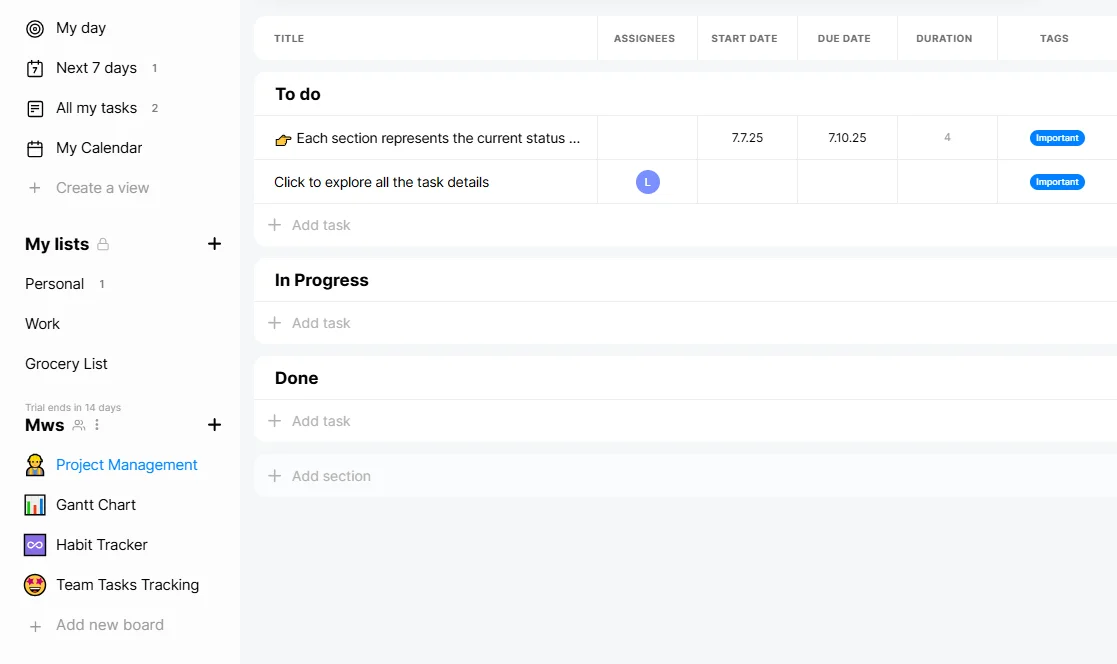
Any.do’s clean task lists and reminders help you organize workflows, stay on top of priorities, and keep your business model on track
Despite a focus on personal use, grocery lists, and families, Any.do does offer some collaboration tools and alternative work views to simple lists, such as Kanban boards in the paid plans.
Standout Features:
- Tasks and lists made simple.
- Calendar and daily planner.
- Widgets to help with events, tasks, meetings, etc.
- Time-based, location, and recurring reminders.
Pros:
- Simplicity and focus on task management.
- New tools added frequently — particularly for automation and collaboration.
- Cross-platform availability.
- Clean, user-friendly interface.
- Custom views and templates available.
Cons:
- Not solely focused on businesses.
- May be overly simple for larger teams.
- No native Google Workspace integration.
- Limited collaboration tools available.
Team Size Scalability
Best for: Individuals, families, and small teams (5-10 users).
Pricing
Free plan: Limited features for individuals.
Paid plans:
- Premium: $4.99/user/month
- Family: $8.33 for up to 4 users/month
- Teams: $4.99/user/month
Remember the Milk
Remember the Milk is a lightweight yet powerful task tracker — perfect for staying on top of to-dos at home or at work
With a simple free version and a more feature-heavy paid version available, the RTM software is targeted at individuals, solo professionals, entrepreneurs, freelancers, and families who want a simple but robust task management tool with some additional features over and above what Google Tasks offers.
Standout Features:
- Smart lists (dynamic filters).
- Reminders, notifications, tags, priorities, and locations.
- Subtasks and recurring tasks.
Pros:
- Simple but powerful user interface.
- Integrates with Gmail and Google Calendar.
- Can share lists and assign them to other people.
Cons:
- Advanced features require a paid plan (e.g., subtasks, advanced filters, unlimited sharing).
- Not focused on teams or businesses.
- No native Google integration.
- Customization mainly in Pro plan.
Team Size Scalability
Best for: Individuals, entrepreneurs, freelancers, and families (1-4 users)
Pricing
Free plan: Basic features
Paid plans:
- Pro: $49.99/user/year
TasksBoard
TasksBoard (not to be confused with the open-source software, Taskboard) is specifically designed as a desktop app for Google Tasks and integrates natively with Google Workspace. You sign in with Google, meaning that no passwords are stored by the app itself.
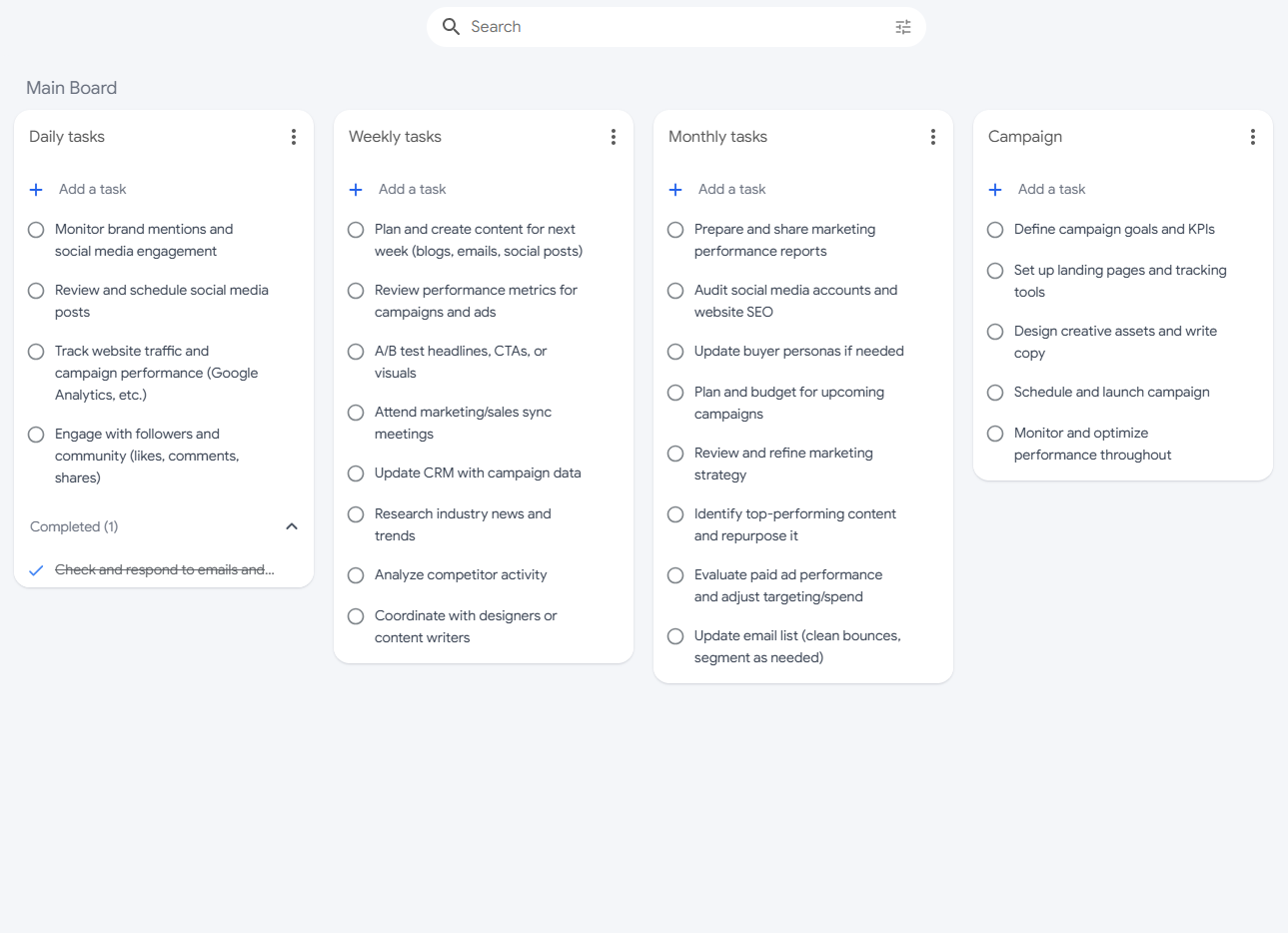
TasksBoard utilizes a simple Kanban-style board for task management. The app is aimed at personal users, professionals, and small teams. The paid plans can handle tasks for multiple projects but larger teams or organizations may want something more feature-heavy with more collaboration and project management tools.
Standout Features:
- Google Tasks viewed in a full-screen Kanban board.
- Share Google Tasks lists in real-time with one link.
- Organize and prioritize tasks with labels.
Pros:
- Fully integrated with Google Workspace.
- Syncs across all devices.
- Customizable labels and tags make task sorting and prioritization simple.
- Secure — no passwords stored.
Cons:
- Limited advanced features.
- No native Google Workspace integrations.
- Not suitable for large teams/projects.
Team Size Scalability
Best for: Individuals, professionals, and small teams (1-10 users).
Pricing
Free plan: Up to 5 shared lists for personal users.
Paid plans:
- Personal Pro: $3.99/month
- Team: $4.99/user/month
TickTick
TickTick is another well-established alternative to Google Tasks, offering an advanced way to manage both the practical and creative side of work/home projects and designed to capture ideas as well as organize tasks.
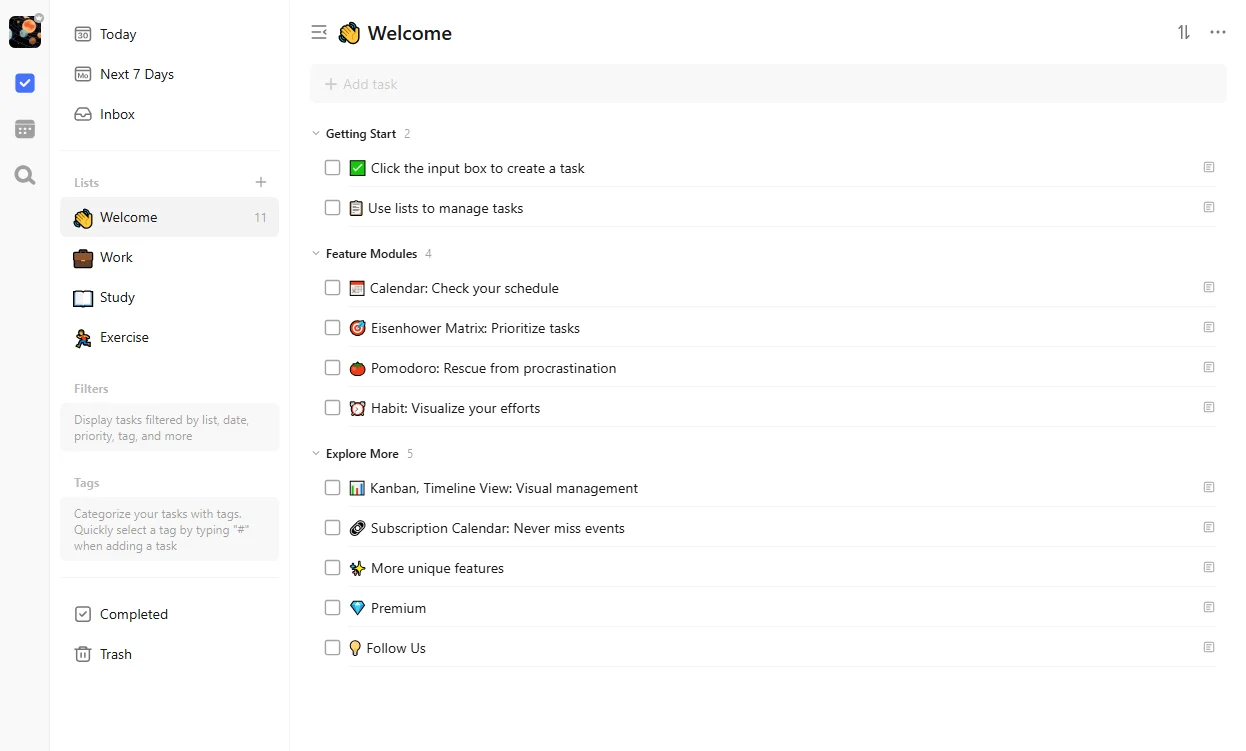
TickTick helps you capture ideas and organize tasks effortlessly — balancing creativity with practicality for productive workflows
You can manage to-do lists, view calendars, track time (Pomodoro style), and share lists with colleagues. Although it’s more advanced than Google Tasks with its features and functionality, TickTick lacks many of the extra collaboration and project management tools of some other solutions outlined here.
Standout Features:
- Drag and drop schedule planner.
- Multiple calendar views.
- Constant and repeat reminders.
- Habit library to help users build good habits.
Pros:
- Advanced task management.
- Focus and productivity tools, including Pomodoro timer, habit tracker, etc. (paid version).
- Basic collaboration tools available (list sharing).
- Some customization options.
Cons:
- Many of the best features are locked behind the paid plan.
- Limited collaboration tools.
- Lack of deep Google Workspace integration.
Team Size Scalability
Best for: Individuals, professionals, and small teams (1-20 users)
Pricing
Free plan: Basic features (limited lists, tags, etc.)
Paid plans:
- Premium: $39.50/user/year
OmniFocus
OmniFocus is a powerful, professional-grade task manager but is predominantly geared towards Apple-using (macOS, iOS) professionals. It works entirely offline and syncs later so is ideal for remote users, as well as privacy-conscious organizations.
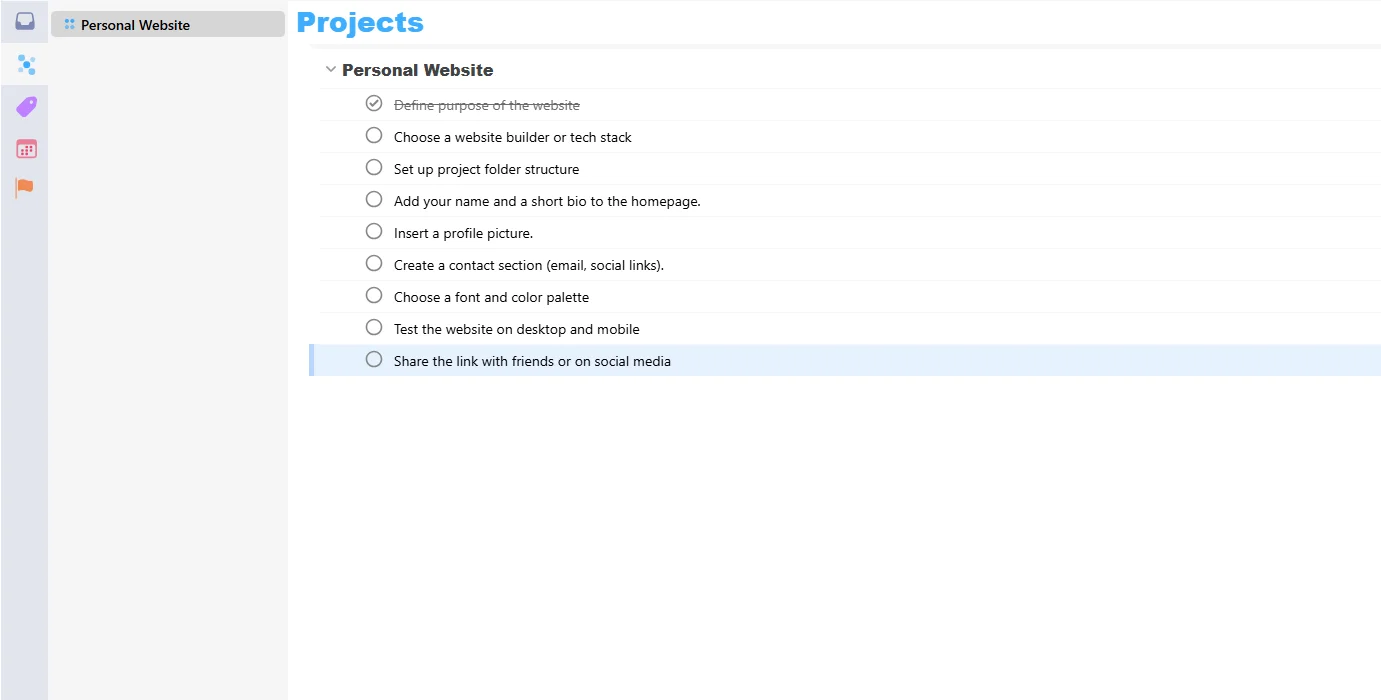
OmniFocus is built for Apple users who want to master their tasks — manage priorities and stay focused across macOS and iOS
This tool is built around the “Getting Things Done” (GTD) workflow method and the web app seems almost like an afterthought. The tool has been designed for iPhones and iPads, with no native Windows, Android or web interface until recently. However, in Mac environments, it can easily handle complex projects if you don’t mind a steep learning curve.
Standout Features:
- Defer dates, sequential task logic, custom filters, etc.
- Custom views (“Perspectives”) using multiple filters.
- Project and task nesting (deep hierarchies).
- Offline-first functionality.
Pros:
- Works seamlessly in an Apple environment.
- Advanced task management features.
- Capability to manage complex projects.
- Privacy: works offline and syncs later.
Cons:
- Mac-only target users.
- No native Google Workspace, Windows or Android integrations.
- Non-user-friendly interface.
- No free plan (free trial offered).
- Steep learning curve.
Team Size Scalability
Best for: Small to mid-size teams (5-50 users) in Mac-only environments.
Pricing
Free plan: None
Paid plans:
- $99.99/year for a subscription for Mac and Web or $49.99/year just for Web.
Read more articles related to Project Management
Try Kanbanchi — The Best Google Tasks Alternative
That completes our overview of 15 Google Tasks alternatives. Which solution suits you best depends on your priorities and goals with the software, your work environment, the team size, and your budget.
For Google Workspace environments, Kanbanchi is one of only a couple of alternatives to Google Tasks specifically designed to work seamlessly in Google environments by small to mid-sized teams.
Purpose-built around the Kanban board methodology, Kanbanchi was designed for user-friendly task management, team collaboration, and seamless project management within the Google Workspace ecosystem, making it the number one choice as a budget-friendly or free Google Tasks alternative.
You can try it today for free…
